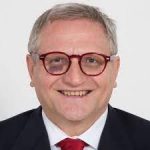Two worlds: the virtual world from the media, and the real world from the people. This is the amazing gap one realizes arriving to Jerusalem, from the very first time.
From my initial Italian perspective, the city hardly existed in my childish and adolescent imagination, except for Biblical television movies or Catholic religious teaching. As an adult, I started to feel attracted by the mystery of the city’s symbolic meaning through the centuries, confident that my University studies and library research could be sufficient to satisfy my thirsty curiosity. I soon developed a desire to contribute to the analysis – and possible resolution – of the decades-long conflict between Israelis and Palestinians.
Gradually, I realised that the sources of information and opinions I was coming across were generally biased, and often times even misleading. The more people, journalists, professors and book authors kept shouting in peremptory and aggressive terms clear-cut conclusions pro or against one of the protagonists in the Arab-Israeli arena, the more I felt that their basical assumptions were in fact groundless, if not completely false.
What to do then? The idea of a field research started whistling the back of my neurons in some unconscious areas of my brain, or maybe dreams. In fact, this hidden desire could emerge to my consciousness only thanks to an apparently hazardous accident of alphabetical order. The late Prof. Luigi Ferrari Bravo, then my Master thesis’ supervisor at the Sapienza University, happened to be also the Legal Advisor of the Italian Foreign Ministry. His closest collegue sitting at the United Nations legal fora was Prof. Ruth Lapidoth, representing another young UN member State whose name likewise started with an ”I”, immediately preceding “Italy”.
To be honest, the subject of my international law thesis on “The problems related to Israel’s borders” was a sort of academic punishment for me, given my insistent requests for an original and challenging research topic. I confessed my doubts to Prof. Lapidoth, who had been warmly encouraged to receive the new young Italian student by her collegue’s friendly letter: was the very idea to send me thousands of miles away for my study on Jerusalem and its Holy Places – a central chapter of my huge neverending Master thesis – actually an educated way to get rid of an overactive student? In any case, Prof. Ferrari Bravo – who was also the editor of the Italian legal journal La Comunità Internazionale (The International Community) – invited me to publish two articles inspired by my thesis’ Jerusalem chapter, and I am grateful to him for introducing me to Ruth, a wonderful guide for me both as a Professor and as a person, an extremely kind and correct lady, full of experience and wisdom.

When in the early nineties I first envisioned my project, I intended to put together a multidisciplinary research that would develop into a thorough study of the Arab-Israeli political and religious contention. The pivotal methodological focus of this research was to observe objectively the relationships on the ground between diplomats, politicians, academics, intellectuals and religious leaders, fully aware of my own Western social and cultural prejudices.
I soon realized that such an ambitious enterprise required patience, humble attitude, open-mind listening, and an extensive amount of time. Therefore, despite my family’s legitimate objections and my mum’s frequent worried calls from home, I took the challenging decision to live in the city for a lasting and intensive period, until I completed my doctoral thesis at the Hebrew University of Jerusalem. I conducted my research from 1994 until 2004, both through the libraries of the Harry S. Truman Research Institute for the Advancement of Peace and through hundreds of meetings with political, academic, religious, administrative, judicial and diplomatic authorities in Israel, Jerusalem, as well as in Ramallah, Jericho, Nablus, Betlehem, Hebron: the main Palestinian towns in the West Bank, where I used to travel once a week.
Was such extensive ten-years period an exaggerated amount of time or a necessary sacrifice for me to grasp the conflict’s deep causes and terrible effects? Eventually, I got the opportunity to meet thousands of ordinary people and experts, and all the parties involved unanimously expressed appreciation for my unbiased research approach with publications, lectures, scholarships, including from Israel, the Holy See and Jordan. Dr. Saeb Erekat, the head of the Palestinian negotiators, came from Jericho to the Tami Steinmetz Institute at the Tel Aviv University to give me from his hands the award for the best doctoral proposal for peace, and the Italian RAI Television hired me as the specialist on the Holy Places for their reports and news on the 2000 Jubilee celebrations in the city.
The inspired and hopeful atmosphere in the city influencing the residents’ expectations I met on my arrival worsened dramatically towards a gloomy and desperate pessimism after 1995 Israeli Prime minister Yitzhak Rabin’s assassination. Terror attacks – including a couple of bombs exploding just a few meters from me – did not succeed to scare me, nor they discouraged my enterprise. I firmly wanted to understand the deep reasons for that horrible conflict: how could I ever give up before getting at least close to its hidden sources and explanations?
Over the years I took part in confidential experts’ meetings, such as at the Israeli Prime minister’s Committee on Jerusalem, chaired by Dr. Moshe Amirav, or at the PLO Negotiations Support Unit in Ramalla. My expertise was requested about the Status Quo at the Jerusalem’s Holy Places from the Ottoman rule. During the 2000 Camp David Negotiations, Italian Legal Advisor Prof. Umberto Leanza suggested me diplomatic case-studies from our legal practice as precedents for the so-called “vertical sovereignty” solution discussed in relation to the sacred compound of the Jerusalem’s Old City, disputed between Israeli Jews and Palestinian Muslims.
Yet, I kept feeling that something was not fully clear and convincing, reclaiming new explanations. Why local leaders hardly had any contact with members of a specific portion of their respective national, ethnic, linguistic or religious group? And why, on the other hand, those very same leaders kept excellent relationships and friendly consultations with a limited section of the “enemy” groups? Day after day, I started to become increasingly aware that cross-cutting alliances and political links surprisingly had no relations with those one could expect following the conflict through television and other mass media.

Personal meetings with the conflict’s protagonists forced me to realize that I needed to deepen my understanding about two powerful Western-based élite groups struggling with each other, exporting their historical rivalry from Europe to the Middle East, especially in Jerusalem. This surprising discovery completely changed the focus of all my research activities, which now revolve around the competition between two parallel interpretations of our socio-political reality: on the one hand the Statalist approach, and on the other the opposite and specular Glocalist one.
The first territorial approach is based upon the land as defined in its material physical meaning, represented by the State frontier as the only significant boundary for any relevant group and collective identity: if you are inside then your are our fellow citizen, if you are outside you are an alien. Accordingly, either you are Israeli or you are Palestinian, regardless of your religious, cultural, family, tribal, linguistic, physical feature or origin. The Statalist élite – and its corresponding Statalist collective identity model – assimilates every citizen to an homogeneous abstract ideal-type.
The second, opposite, transboundary approach is more imaginary and volatile, based on abstract – if not artificial – identitary bonds, flying in the aerial space, or floating on the mutable waves of the ocean: religion, culture, ideology, shared interests (in monetary or financial transnational or multinational assets), race, sectarianism, sport fanaticism, gender, sexual orientation, musical or artistic fans’ grouping, social networking. In one sentence: everything unrelated – often contrasting and challenging – any notion of State boundary as the significant limit for group identity.
With this magnifying lens to hand, the yet undefined concept of Jerusalem becomes the crossroad of debates about competing national (Statalist) and religious (Glocalist) identity models and élites. For example, controversial theories about a Clash of Civilizations, or about a Muslim/Western divide interpret the conflict in Jerusalem using transnational definitions and Glocalist key-words.
My Israeli and Palestinian friends used to tell me that my 30-years study around the extremely sensitive issue of Jerusalem and its Holy Places reminds them of the eye-opening child in the fairy tale of the naked king. I would be satisfied if my work could open up a constructive debate on this intricate issue, leading upcoming generations to an innovative way of understanding international politics and of predicting its complex trends, thus helping to prevent and avoid further painful violence, to be replaced with respectful coexistence.


